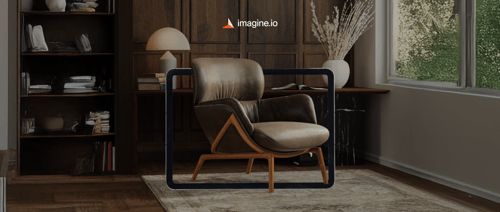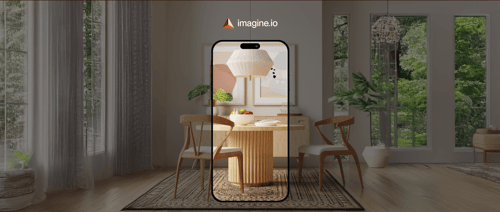You're a procurement manager scrolling LinkedIn, wading through a flood of predictable ads for office furniture or industrial appliances. Most blur into the background static images, dry spec sheets. Then, an ad stops you cold: a 3D model of a modular sofa spins smoothly on your screen. With a click, you're customizing its fabric and placing it in your office via augmented reality (AR). This isn't just another pitch it's a hands-on experience that feels like a demo. This is the future of B2B marketing, and imagine.io is leading the charge, helping brands turn passive clicks into active engagement.
The Visual Revolution in B2B Marketing
LinkedIn has evolved far beyond a networking hub. It's now a critical platform for B2B product discovery, especially for industries like furniture, home decor, appliances, and electronics. Decision-makers aren't just browsing they're researching, comparing, and building trust. But today's buyers expect more than flat images or bullet-point lists. They want immersive experiences that let them see, feel, and interact with products before signing a contract.
Visual commerce is answering that call. The shift from static assets to dynamic 3D visualizations and AR experiences is transforming how brands stand out. According to a recent market analysis, the global AR market was worth $93.67 billion in 2024 and is expected to surge to $1,716.37 billion by 2032, growing at a 43.0% CAGR. North America led with a 31.29% share in 2024, with the U.S. AR market projected to reach $342.73 billion by 2032. This explosive growth reflects a hunger for interactive tools that bridge the gap between digital browsing and real-world decision-making, particularly in regions like Austin, New York, and Chicago.
AR in Action: Real Results on LinkedIn
Consider a global furniture brand rolling out a new line of customizable office desks. Using imagine.io's cloud-based platform, they embed AR visuals into LinkedIn sponsored posts and InMail campaigns. Prospects can rotate the desk, swap out wood finishes, and visualize it in their workspace all without leaving the platform. The payoff? A 25% spike in click-through rates, a 15% drop in bounce rates, and a flood of lead-gen form submissions. Buyers aren't just clicking; they're lingering, exploring, and converting.
Why does this resonate? AR makes complex products tangible. For industries like appliances or electronics, where customization drives decisions, interactive visuals showcase options in ways static images can't. Imagine.io's all-in-one platform delivers everything images, videos, 360-degree views, and configurators making it easy to create compelling assets for brands like KitchenAid or Kohler. By integrating with LinkedIn's lead-gen tools, these campaigns capture high-intent prospects who are already sold on the product's value.
Case Study: Scaling Engagement
Take a hypothetical appliance manufacturer targeting buyers in Dallas and Los Angeles. Their LinkedIn campaign features an AR-enabled ad for a smart refrigerator. Prospects can explore features like adjustable shelves or see the unit in their kitchen via AR. The campaign's interactive carousel drives 30% more engagement than traditional ads, with prospects spending three times longer interacting. Retargeting based on interaction data clicks, customization choices further boosts conversions, proving AR's power to move buyers down the funnel.
Breaking Down Barriers to AR Adoption
Despite the momentum, some brands hesitate. “We don't have 3D assets,” they argue. Or, “AR feels too flashy for B2B.” Others worry about scaling across thousands of SKUs or tailoring campaigns for markets like Canada or Las Vegas. These objections are real but surmountable.
Imagine.io dismantles these hurdles. Its no-code platform lets brands upload a single 3D model and generate studio-quality assets in minutes indistinguishable from traditional photoshoots, according to eCommerce experts. Need to scale? The cloud-based system offers unlimited image outputs, perfect for brands with sprawling catalogs, like those in High Point's furniture market or Chicago's retail scene. As for the “gimmick” concern, AR's measurable ROI higher engagement, better lead qualification proves it's a serious B2B tool, not a novelty.
Pricing is another sticking point. Some brands prefer one-off projects over subscriptions. But imagine.io's custom pricing adapts to each client's needs, offering flexibility that rigid competitors can't match. It's not about locking brands in; it's about empowering them to create at scale without breaking budgets, whether they're in New York or beyond.
AR's Strategic Edge in B2B Funnels
AR doesn't just look good it delivers results. By embedding interactive visuals in LinkedIn campaigns, brands see lifts across key metrics. Early-funnel product education improves as buyers explore features hands-on. Interaction data click heatmaps, time spent, customization patterns helps qualify leads before sales outreach. Conversion rates climb when prospects can visualize products in context, with one furniture brand reporting a 20% increase in demo requests after adopting AR ads.
Cost efficiency is a hidden gem. Traditional photoshoots for complex catalogs are slow and expensive. Imagine.io's platform cuts production time dramatically, letting brands like Ruggable generate assets in-house without endless A/B testing. As a market report highlights, advancements in AR, AI, and wearable tech are driving adoption in retail and manufacturing, with compact, powerful tools making immersive content accessible to businesses of all sizes.
Why It Works Across Industries
From furniture to appliances, AR's versatility shines. A beverage brand like PepsiCo could showcase vending machine designs in AR, letting buyers customize layouts. A lighting company like Kichler could let architects visualize fixtures in virtual spaces. The ability to tailor experiences to specific industries and regions think Las Vegas showrooms or Canadian eCommerce makes AR a universal fit for B2B.
Your Playbook for AR on LinkedIn
Ready to dive in? Start with a pilot: choose a high-impact product, like a customizable sofa or appliance, and create an AR-enabled LinkedIn ad. Use imagine.io to integrate 3D visuals into your asset workflows, ensuring seamless deployment across sponsored posts or InMail. Track metrics like interaction time and click heatmaps to refine your approach. Then, scale up, localizing visuals for markets like Los Angeles or Dallas using imagine.io's versioning tools.
Collaboration is critical. Share interaction data with sales teams to prioritize high-intent leads those tweaking configurations or spending time in AR. Amplify your efforts on social platforms like Instagram or YouTube, where buyers already expect rich visuals. The result is a cohesive strategy that drives engagement and conversions across channels.
The Interactive Future Awaits
Static ads are losing ground in B2B marketing. Today's buyers whether in Chicago, High Point, or Canada demand experiences that bring products to life. With the AR market set to hit $1.7 trillion by 2032, the time to act is now. Platforms like imagine.io make it easy to create scalable, high-quality visuals that turn LinkedIn browsers into buyers. Why settle for flat when you can go immersive? The future of B2B marketing is here, and it's powered by AR.
Frequently Asked Questions
How does augmented reality (AR) improve B2B conversion rates on LinkedIn campaigns?
AR experiences significantly boost B2B conversions by allowing prospects to interact with products directly within LinkedIn ads. Companies using AR-enabled LinkedIn campaigns have seen up to 25% higher click-through rates and 15% lower bounce rates. The technology transforms passive browsing into active engagement, helping buyers visualize products in their own workspace before making purchasing decisions.
What industries benefit most from using AR in LinkedIn B2B marketing campaigns?
AR marketing works particularly well for visual industries like furniture, home decor, appliances, and electronics on LinkedIn. These sectors benefit from AR's ability to showcase customizable products, allow prospects to explore features hands-on, and visualize items in their actual workspace. Companies in furniture manufacturing, kitchen appliances, and office equipment have reported 20% increases in demo requests after implementing AR ads.
Is AR technology too expensive or complex for small B2B companies to implement on LinkedIn?
Modern AR platforms have made the technology accessible and cost-effective for businesses of all sizes. Cloud-based solutions can generate studio-quality 3D assets from a single model in minutes, eliminating expensive photoshoots and reducing production time dramatically. Many platforms offer flexible pricing models that adapt to different business needs, making AR implementation scalable without breaking budgets for companies targeting markets from local regions to international audiences.
Disclaimer: The above helpful resources content contains personal opinions and experiences. The information provided is for general knowledge and does not constitute professional advice.
You may also be interested in: Imagine.io | Award Winning 3D + AI Product Visualization
Struggling with expensive, outdated product visuals that slow down your creative process and stunt eCommerce growth? imagine.io's AI-powered platform empowers furniture, home décor, and textile brands to effortlessly produce striking 3D images, immersive videos, AR experiences, and interactive configurators. Cut production costs up to 70%, boost conversions 5X, speed up prototyping, and supercharge your online sales. Ready to elevate your product visuals and captivate customers? Book a demo with imagine.io today!
Powered by flareAI.co




.png?width=500&name=How%20to%20Add%20a%203D%20Product%20Configurator%20to%20Your%20WordPress%20Website%20(Complete%20B2B%20Guide).png)
















%20(1).png?width=500&name=Why%20Exploded%20Mattress%20Views%20Matter%20(And%20How%20to%20Generate%20Them)%20(1).png)
.png?width=500&name=Best%20Shopify%20Product%20Configurator_%20How%20to%20Choose%20the%20Right%20One%20(2).png)
.png?width=500&name=Why%20Exploded%20Mattress%20Views%20Matter%20(And%20How%20to%20Generate%20Them).png)



.png?width=500&name=Best%20Shopify%20Product%20Configurator_%20How%20to%20Choose%20the%20Right%20One%20(1).png)







.png?width=500&name=How%203D%20Rendering%20Can%20Make%20or%20Break%20Your%20Industrial%20Design%20Pitch%20(1).png)








%20with%20Digital%20Twins%20and%203D%20Visualization.png?width=500&name=Optimizing%20Your%20Digital%20Asset%20Management%20(DAM)%20with%20Digital%20Twins%20and%203D%20Visualization.png)




.png?width=500&name=Styling%20Home%20Decor%20for%202025_%20From%20Global%20Influences%20to%20Playful%20Personalization%20(1).png)
